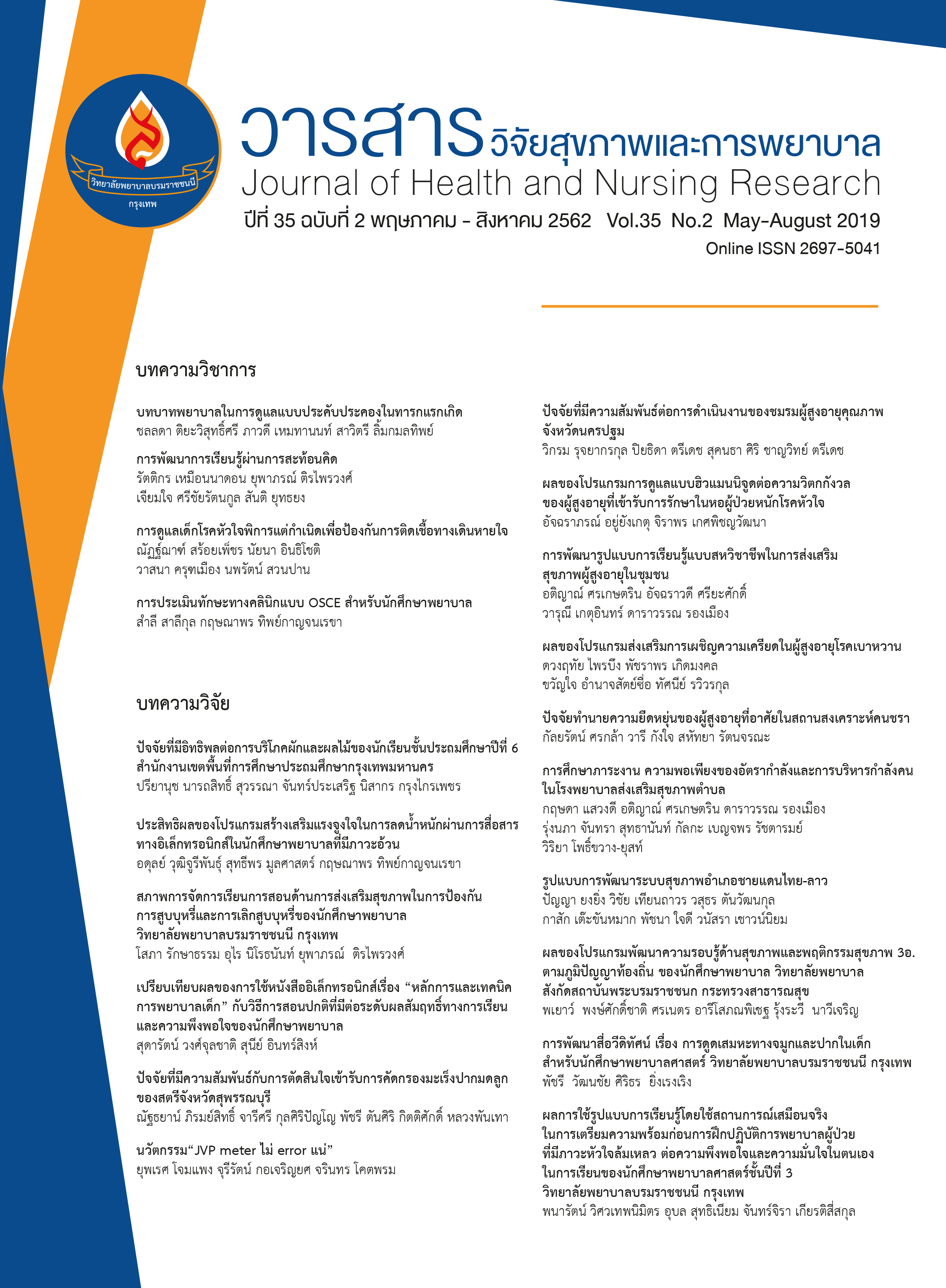เปรียบเทียบผลของการใช้หนังสืออิเล็กทรอนิกส์เรื่อง “หลักการและเทคนิคการพยาบาลเด็ก” กับวิธีการสอนปกติที่มีต่อระดับผลสัมฤทธิ์ทางการเรียนและความ พึงพอใจของนักศึกษาพยาบาล
คำสำคัญ:
หนังสืออิเล็กทรอนิกส์, หลักการและเทคนิคการพยาบาลเด็ก, ผลสัมฤทธิ์ทางการเรียน, ความพึงพอใจ, นักศึกษาพยาบาลบทคัดย่อ
การวิจัยกึ่งทดลองครั้งนี้ มีวัตถุประสงค์เพื่อ 1) เปรียบเทียบผลสัมฤทธิ์ทางการเรียนระหว่างการเรียนด้วยหนังสืออิเล็กทรอนิกส์เรื่องหลักการและเทคนิคการพยาบาลเด็กกับวิธีการสอนแบบปกติ 2) เปรียบเทียบความพึงพอใจของนักศึกษาระหว่างการเรียนด้วยหนังสืออิเล็กทรอนิกส์กับวิธีการสอนแบบปกติ
กลุ่มตัวอย่างที่ใช้ในการวิจัยเป็นนักศึกษาพยาบาลศาสตร์ชั้นปีที่3 คณะพยาบาลศาสตร์ วิทยาลัยเซนต์หลุยส์ แบ่งเป็นกลุ่มละ 30 คน เครื่องมือที่ใช้ในการดำเนินการวิจัย คือ 1) หนังสืออิเล็กทรอนิกส์เรื่องหลักการและเทคนิคการพยาบาลเด็ก ทดลองใช้มีค่าสัมประสิทธิ์แอลฟาครอนบาค เท่ากับ 0.67 อยู่ในระดับดีมากที่สุด ค่าเฉลี่ย = 4.73 ส่วนเบี่ยงเบนมาตรฐาน = 0.16 2) คู่มือหลักการและเทคนิคการพยาบาลเด็ก 3) แบบทดสอบความรู้ก่อนและหลังเรียน ทดลองใช้หาค่าความเชื่อมั่น มีค่า KR-20 เท่ากับ 0.84 4) แบบประเมินทักษะการปฏิบัติ 5) แบบสอบถามความพึงพอใจของนักศึกษาต่อการจัดการเรียนการสอน ทดลองใช้มีค่าสัมประสิทธิ์แอลฟาครอนบาค เท่ากับ 0.94 วิเคราะห์ข้อมูลด้วยการแจกแจงความถี่ ร้อยละ ค่าเฉลี่ย ส่วนเบี่ยงเบนมาตรฐาน และการทดสอบค่าที
ผลการวิจัยพบว่า 1) คะแนนเฉลี่ยความรู้หลังเรียนของกลุ่มที่เรียนด้วยหนังสืออิเล็กทรอนิกส์เรื่องหลักการและเทคนิคการพยาบาลเด็กมากกว่ากลุ่มที่เรียนด้วยวิธีการสอนแบบปกติ อย่างมีนัยสำคัญทางสถิติที่ระดับ .001 2) คะแนนเฉลี่ยปฏิบัติหลักการและเทคนิคการพยาบาลเด็กของกลุ่มที่เรียนด้วยหนังสือ
References
2. Suttirat C. Curriculum development: Theory to practice. 4th ed. Bangkok: Vimpint, 2015. (in Thai)
3. Mooncome S, Mooncome O. Learn how to develop moral values, ethics, self-seeking knowledge. 9nd ed. Bangkok: Parbpim, 2010. (in Thai)
4. Husadeang K. New steps of E-book in 21st Century; 2013. Available from http://kmlibrary.bu.ac.th/ (in Thai)
5. Biranvand A, Khasseh AA. E-book reading and its impact on academic status of students at Payame Noor University, Iran. University of Nebraska-Lincoln. Library Philosophy and Practice (e-journal), 2014 Dec Available from https://digitalcommons.unl.edu/cgi/viewcontent.cgi?article=3033&context=libphilprac
6. Songkram N. Multimedia for learning: Design and development of. 3rd ed. Bangkok: Vimpint, 2014. (in Thai)
7. Reungrong P. E-book on mobile and E-book on Tablet PC. Bangkok: Pornticha Printing, 2014. (in Thai)
8. Gibson C, Gibb F. An evaluation of second-generation eBook readers. Electronic Library. 2011;29(3):303-19.
9. Gueval J, Tarnow K, Kumm S. Implementing e-books: Faculty and student experiences. Teaching and learning in nursing 2015;10:181–5.
10. Rainie L, Wellman B. Network: The new social operation system. USA: Massachusetts Institute ofTechnology, 2011.
11. Faculty of Economics, Chulalongkorn University and Research Centre for Social and Business
Development. The reading culture and buying books of Thai people 2015. [online] Available from:
URL:http//thaipublica.org/wp-content/uploads/2016/04/2558
12. Kimsungnoen N, Petchtang S. The effect of E-Learning courseware media on the learning achievement of nursing students at the school of nursing, Rangsit University. Thai Red Cross Nursing Journal 2016;9(1):64-74. (in Thai)
13. Yimyam S, Chareonsanti J, Karnasuta S. Development of multimedia electronic book on basic
knowledge of breastfeeding for nursing students. Nursing Journal 2014;41(4):70-82. (in Thai)
14. Cohen J. Statistical power analysis for the behavior sciences. 2nd ed. USA: Lawrence Erlbaum Associates; 1988.
15. Mamom J. Outcomes of computer-mediated review lesson on pressure-sore dressing as observed
in second-year nursing students’ knowledge, practical skills and opinions, Thai Journal of Nursing
Council 2012; 27(3):63-76. (In Thai)
16. Sajjanonda P, Rodcumdee B. The effect of computer assisted instruction in supportive educative nursing system on self care behaviors of school-age children with congenital heart disease. Journal of Nursing Science Chulalongkorn University 2015; 27(2):48-59. (in Thai)
17. Wiboonlyasarin W. Innovation and teaching materials in Thai language. 2nd ed. Bangkok: Vimpint, 2014. (In Thai)
18. Srivilai W, Atthamaethakul W. Develop of and electronic book on anatomy of the cardiovascular system and the lymphatic vascular system. Journal of Nursing and Education 2010;4(1):29-37. (in Thai)
19. Pakdeto R, Sawasdipanich N, Suntiti. Effect of a computer-assisted instruction of nursing care of children with intravenous fluid therapy toward knowledge and clinical decision-making of nursing students. Journal of Boromarajonani College of Nursing, Bangkok 2013;29(1):110-20. (in Thai)
20. Stiriling A, Birt J. (2014). An enriched multimedia eBook application to facilitate learning of anatomy. Anat Sci Educ 2014;7(1):19-27.
21. Phantevee V. People’s satisfaction toward the service of the Ministry of Interior’s Agencies in Muang district, Mae Hong Son Province. Master Thesis of Political science. Chiang Mai University; 1999.(in Thai)
Downloads
เผยแพร่แล้ว
How to Cite
ฉบับ
บท
License
บทความที่ได้รับการตีพิมพ์ เป็นลิขสิทธิ์ของวารสารวิจัยสุขภาพและการพยาบาล (วิทยาลัยพยาบาลบรมราชชนนี กรุงเทพ) ไม่สามารถนำไปตีพิมพ์ซ้ำในวารสารฉบับอื่น

















